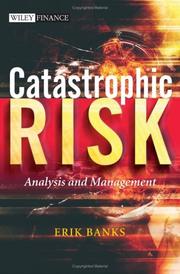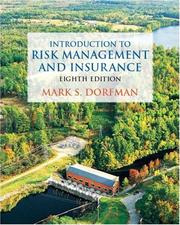| Listing 1 - 10 of 562 | << page >> |
Sort by
|
Periodical
ISSN: 21533792 17932157 Year: 2005 Publisher: Berkeley, CA : [Berlin Germany] : Berkeley Electronic Press De Gruyter
Abstract | Keywords | Export | Availability | Bookmark
 Loading...
Loading...Choose an application
- Reference Manager
- EndNote
- RefWorks (Direct export to RefWorks)
Risk (Insurance) --- Insurance --- Risk
Book
ISBN: 8952103491 Year: 2005 Publisher: 서울 서울대학교출판부
Abstract | Keywords | Export | Availability | Bookmark
 Loading...
Loading...Choose an application
- Reference Manager
- EndNote
- RefWorks (Direct export to RefWorks)
Risk management --- Risk perception --- Risk-taking (Psychology)
Book
ISBN: 1282052896 0191534943 9786612052897 Year: 2005 Publisher: Oxford : Oxford University Press,
Abstract | Keywords | Export | Availability | Bookmark
 Loading...
Loading...Choose an application
- Reference Manager
- EndNote
- RefWorks (Direct export to RefWorks)
"This book evaluates alternatives in widening insurance and social protection provision - including sustainability and poverty effects, in thematic papers and case studies, development assessments, and policy analyses"--Provided by publisher.
Book
Year: 2005 Publisher: Bruxelles: UCL,
Abstract | Keywords | Export | Availability | Bookmark
 Loading...
Loading...Choose an application
- Reference Manager
- EndNote
- RefWorks (Direct export to RefWorks)
Une entreprise d’isolation thermique industrielle a demandé l’aide de on conseiller en prévention sécurité et du médecin du travail pour l’établissement d’un plan d’action dynamique de son atelier de production. Cette demande s’inscrit également dans le cadre d’une reconnaissance VCA de cet atelier.
L‘analyse des risques a été faite selon la méthode Kinney–Wiruth dans un premier temps et la méthode Déparis dans un second temps. Pour la méthode Kinney–Wiruth, le conseille en prévention sécurité et le médecin firent une identification collégiale des risques de chaque poste de travail et donnèrent une évaluation quantitative et personnelles à chaque risque. Devant la discordance de ces résultats, et afin de conclure l’étude, un consensus a été trouvé : évaluation quantitative et collégiale de chaque risque discordant. Lors de la mise en place de la méthode Déparis, un groupe de travail a été constitué comprenant des travailleurs volontaires, un représentant de la ligne hiérarchique, le conseiller en prévention sécurité et le médecin du travail, ce dernier en qualité de modérateur de la réunion.
Cette analyse des risques (Déparis) a permis d’établir une liste de problèmes à solutionner avec identification des intervenants et les délais d’actions souhaités.
La comparaison d’une méthode quantitative (Kinney–Wiruth) et d’une méthode qualitative (Déparis) est nettement en faveur de Déparis pour les raisons suivantes :
- Participation des travailleurs au dépistage des risque de leurs poste de travail ;
- Aucune connaissance ergonomique – spécialisée n’est requise ;
Mise en place d’un outil de dépistage des risque réutilisable par l’entreprise elle-même ;
Méthodes plus économique et plus valorisante pour les divers intervenants (travailleur – employeurs – conseillers en prévention)
Book
Abstract | Keywords | Export | Availability | Bookmark
 Loading...
Loading...Choose an application
- Reference Manager
- EndNote
- RefWorks (Direct export to RefWorks)

ISBN: 0470012366 Year: 2005 Publisher: West Sussex Wiley
Abstract | Keywords | Export | Availability | Bookmark
 Loading...
Loading...Choose an application
- Reference Manager
- EndNote
- RefWorks (Direct export to RefWorks)
Book
ISBN: 7030145305 Year: 2005 Publisher: 北京 科学出版社
Abstract | Keywords | Export | Availability | Bookmark
 Loading...
Loading...Choose an application
- Reference Manager
- EndNote
- RefWorks (Direct export to RefWorks)
Book
Year: 2005 Publisher: [Washington, D.C. : World Bank,
Abstract | Keywords | Export | Availability | Bookmark
 Loading...
Loading...Choose an application
- Reference Manager
- EndNote
- RefWorks (Direct export to RefWorks)
"The most basic argument for insurance is that it reduces financial risk. But since insurance opens up new opportunities for consuming expensive high-technology care which permits health improvements that are valued by the insured, and because in many settings the provider is able and has an incentive to exploit the informational advantage he has over the patient, it is not immediately obvious that insurance will in practice reduce financial risk. The authors analyze the effect of insurance on the probability of an individual incurring "high" annual health expenses using data from three household surveys-one a cross-section survey, the other two panel surveys. All come from China, a country where providers have until recently largely been paid fee-for-service (often according to a schedule that encourages the overprovision of high-technology care and the underprovision of basic care) and who are only lightly regulated. The authors define annual spending as "high" if it exceeds 5 percent of average income in the sample and as "catastrophic" if it exceeds 10 percent of the household's own per capita income. The estimates of the effect of insurance on financial risk allow for the possible endogeneity of health insurance in the panel datasets by allowing for a time-invariant fixed effect capturing unobserved risk that may be correlated with insurance status, and in the cross-section dataset by using instrumental variables, where availability of and eligibility for health insurance are used as instruments. The results suggest that during the 1990s China's government and labor insurance schemes increased financial risk associated with household health care spending, but that the rural cooperative medical scheme significantly reduced financial risk in some areas but increased it in others (though not significantly). From the results, it appears that China's new health insurance schemes (private schemes, including coverage of schoolchildren) have also increased the risk of high levels of out-of-pocket spending on health. Where the authors find evidence of health insurance increasing the risk of "high" out-of-pocket expenses, the marginal effect is of the order of 15-20 percent; in the case of "catastrophic" expenses, it is even larger. "--World Bank web site.
Financial risk. --- Health insurance --- Risk
Book
Year: 2005 Publisher: [Washington, D.C. : World Bank,
Abstract | Keywords | Export | Availability | Bookmark
 Loading...
Loading...Choose an application
- Reference Manager
- EndNote
- RefWorks (Direct export to RefWorks)
"The most basic argument for insurance is that it reduces financial risk. But since insurance opens up new opportunities for consuming expensive high-technology care which permits health improvements that are valued by the insured, and because in many settings the provider is able and has an incentive to exploit the informational advantage he has over the patient, it is not immediately obvious that insurance will in practice reduce financial risk. The authors analyze the effect of insurance on the probability of an individual incurring "high" annual health expenses using data from three household surveys-one a cross-section survey, the other two panel surveys. All come from China, a country where providers have until recently largely been paid fee-for-service (often according to a schedule that encourages the overprovision of high-technology care and the underprovision of basic care) and who are only lightly regulated. The authors define annual spending as "high" if it exceeds 5 percent of average income in the sample and as "catastrophic" if it exceeds 10 percent of the household's own per capita income. The estimates of the effect of insurance on financial risk allow for the possible endogeneity of health insurance in the panel datasets by allowing for a time-invariant fixed effect capturing unobserved risk that may be correlated with insurance status, and in the cross-section dataset by using instrumental variables, where availability of and eligibility for health insurance are used as instruments. The results suggest that during the 1990s China's government and labor insurance schemes increased financial risk associated with household health care spending, but that the rural cooperative medical scheme significantly reduced financial risk in some areas but increased it in others (though not significantly). From the results, it appears that China's new health insurance schemes (private schemes, including coverage of schoolchildren) have also increased the risk of high levels of out-of-pocket spending on health. Where the authors find evidence of health insurance increasing the risk of "high" out-of-pocket expenses, the marginal effect is of the order of 15-20 percent; in the case of "catastrophic" expenses, it is even larger. "--World Bank web site.
Financial risk. --- Health insurance --- Risk

ISBN: 0131449583 Year: 2005 Publisher: New York (N.Y) Prentice Hall
Abstract | Keywords | Export | Availability | Bookmark
 Loading...
Loading...Choose an application
- Reference Manager
- EndNote
- RefWorks (Direct export to RefWorks)
Insurance --- Risk (Insurance) --- Risk management
| Listing 1 - 10 of 562 | << page >> |
Sort by
|

 Search
Search Feedback
Feedback About
About Help
Help News
News